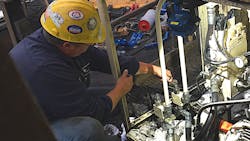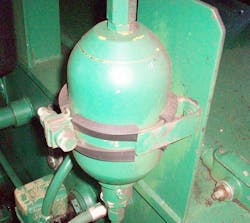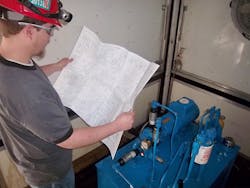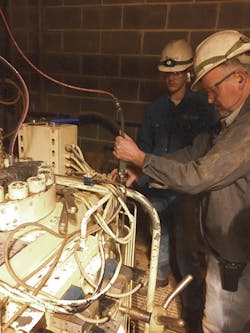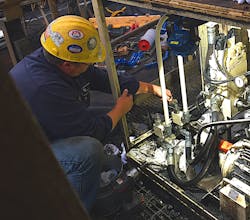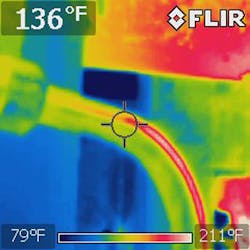Five Things a Hydraulic Troubleshooter Needs to Know
When our company started in 1994, it was our mission to increase the knowledge of millwrights, mechanics, electricians, supervisors and reliability technicians tasked with the repair and maintenance of fluid power systems. We travel extensively and have met many thousand such maintenance professionals but have found actual troubleshooters to be quite rare.
Mostly, the professionals we meet have been excellent fluid power parts changers—people who have worked on and around a particular system for so long and have seen it fail in so many ways that they know when certain problems arise, and which component will usually correct it when replaced. This works fine so long as, when the part is changed, the problem goes away. The trouble comes when the parts changer changes the part and it does not correct the problem.
When this happens, the parts changer will typically change something else. Usually, this parts-changing process continues until one of two things happens: Either we get the system back in service or we put it in such a state that someone must be called to the plant to assist.
It has always been our goal to reduce this downtime by helping parts changers become troubleshooters. It has always been our belief that there are five things someone needs to know in order to be a real hydraulic troubleshooter.
1. The Function of All of the Components
The first thing any troubleshooter needs to know is what every component does in the system. This may sound easier than it is. Many components look similar but perform different functions, particularly the ones mounted in manifolds in a cartridge form. A cartridge-type flow control can easily be mistaken for a relief valve, pressure-reducing valve or other pressure control.
An accumulator can have several different purposes—flow assistance, shock absorption or emergency energy storage. If we don’t know what a component does, we have no way of knowing if it could be causing our problem or not.
2. How to Read and Use a Schematic as a Troubleshooting Tool
Most industrial systems are much too large and complex to troubleshoot without a schematic. Often, portions of a machine are in different rooms or even different buildings. The schematic shows how the entire system is plumbed, allowing the troubleshooter to trace the flow and use his knowledge of the function of the components to eliminate those that could not be causing the problem and identify those that could be.
Trying to trace the flow without a schematic can be laborious at best, but impossible in some cases. It is usually possible to troubleshoot something simple such as a log splitter without a schematic, but anything much more complex requires a schematic.
If a system has manifolds, troubleshooting is impossible without a schematic. Since we aren’t Superman with X-ray eyes, we have no way of knowing exactly how components are connected inside a manifold. There may be internal plugs or orifices and there may be cross connections we are unaware of. Without a schematic, the best anyone can do with a manifold is make an educated guess.
The best five minutes ever spent troubleshooting a system will be spent tracing the flow on the schematic. In fact, we go so far as to say that, if you are not using a schematic as a troubleshooting tool, you aren’t really troubleshooting. You are really parts changing.
3. How to Troubleshoot Individual Components, Preferably Without Removing Them from the System
Suppose that, based on our knowledge of the function of the components and our ability to trace the flow on the schematic we determine that there are only, say, three components that could possibly cause the symptoms we are seeing? Why not just change all three of them and be finished with it?
This could sound like the most efficient path to take. After all, unscheduled downtime can run well into the five figures (and sometimes six figures!) depending upon the plant and specific machine. This can make the cost of a couple of unnecessary parts seem insignificant compared to the additional troubleshooting time. We have known many people to do exactly this in the interest of getting the system back online as quickly as possible. This is a mistake.
If we change multiple components, we don’t know which one corrected the issue. This is critical information if we wish to perform Root Cause Failure Analysis. Even beyond unnecessary parts cost and the inability to determine the root cause of the problem, the most important reason not to do this is the risk of contamination. Whenever a component is removed from the system, the lines are opened to airborne contaminants. Industrial plants are notorious for these contaminants, but even the cleanest of environments will have large enough particles to do damage. Microscopic particles much too small to see can wreak havoc with a hydraulic system. We could do everything correctly, follow all best practices and still contaminate the system, so we wouldn’t want to take the chance of removing it from the system, unless we had very good reason to believe that a component is bad.
Almost all components show specific symptoms when they fail. By using proper troubleshooting techniques, the worn component can be determined, usually quite quickly. While it is possible to repair the system by changing multiple components, it’s also possible to add a problem or two. Usually, by the time we are called to assist, a lot of parts changing has occurred. Often, what began as a relatively simple problem has escalated to multiple issues, much more difficult to diagnose.
4. How to Properly Adjust the System
A surprising number of failures are the result of bad adjustments or the failure to keep the system adjusted. We have often had to drive for several hours or, in a few cases, even fly across the country to do nothing more than tell someone to make an adjustment. A badly adjusted component is often no better than a bad component. It is imperative that the troubleshooter knows which adjustments to make and the proper procedures for making them.
5. The Correct Reliability Checks to Make
A real troubleshooter also knows which reliability checks to make on a scheduled basis in order to spot components that are becoming worn before an outage can occur. Many people believe that hydraulic components are like lightbulbs—they are good until one day they aren’t. This is simply not true. Yes, catastrophic failures do occur, but truly they are quite rare.
Most component wear is a very gradual thing and symptoms begin to show long before the component fails completely. If the troubleshooter knows what to look for, these symptoms are usually very easy to spot. Most commonly, a temperature gain across a component will be its first indication of impending failure.
Naturally, in order to spot an abnormally high temperature gain, we must have some idea of what “normal” is. Also, “normal” may vary throughout the year in systems exposed to the elements, so we usually will experience different ambient temperatures in August than in February. We typically recommend monthly reliability checks on most components, so we know what is normal for February, August and every other month.
If a good reliability schedule is followed, there is very little that is hydraulic or pneumatic that can fail without us being aware that it was becoming worn. Ideally, wear is spotted during reliability checks and components are replaced only during scheduled outages. Nothing is more expensive than lost production, especially because of something that could have been avoided by regular checks.
6. Safety
Yes, this article is titled “The Five Things a Hydraulic Troubleshooter Needs to Know,” but here is a sixth for good measure. The reason it is not included in its own category is that it applies across the board. Whether you are a parts changer or a troubleshooter, if you are going to be working on or around a hydraulic system, safety must remain first in your mind. Pay attention to all lockout/tagout procedures, and if there are any you do not understand, ask someone.
Don’t just know the rules, know why they are in place. There are hundreds of examples of people needlessly injured or killed as a result of not understanding the basics of hydraulic safety. Never go to work on a system that is not in a zero-energy state. Even a low pressure has the potential of causing injury or death. Be aware of the parts of the system that can store energy even if the system is shut down. Never look for a pinhole leak by running your hand up and down a pipe or hose—you might find it!
If any procedure seems unsafe to you, share your concerns with a supervisor. A surprising number of safety practices are the result of suggestions by people recently hired. Remember, no job is so important that it cannot be performed safely!
Jack Weeks is an instructor and consultant at GPM Hydraulic Consulting, Inc.About the Author
Jack Weeks
Instructor and Consultant, GPM Hydraulic Consulting, Inc.

Leaders relevant to this article:
